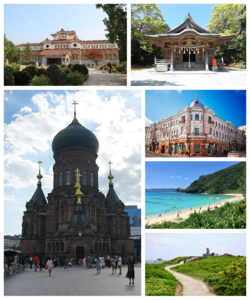Yedo: Difference between revisions
m (→Etymology) |
|||
| Line 137: | Line 137: | ||
==Etymology== | ==Etymology== | ||
Yedo, in Esonian, directly translates to "inlet bay". The name reflects the city's location at the mouth of the Nagihaya Bay and the Shimto Channel. | Yedo, in Esonian, directly translates to "inlet bay". The name reflects the city's location at the mouth of the Nagihaya Bay and the Shimto Channel. This positioning made Yedo an important coastal settlement, both for maritime trade and as a natural harbor. Historically, such names were common in Esonian culture, where geographical features played a major role in the identity of a settlement. The combination of Nagihaya Bay and the Shimto Channel made Yedo not only a safe harbor but also a vital link between inland routes and broader maritime trade networks. The name “inlet bay” captures both the natural geography and the city’s role as a gateway between land and sea. | ||
==History== | ==History== | ||
| Line 190: | Line 190: | ||
==Culture== | ==Culture== | ||
Yedo is commonly seen as a cultural melting pot. Put | |||
==Demographics== | ==Demographics== | ||
Revision as of 19:20, 11 September 2024
This article is incomplete because it is pending further input from participants, or it is a work-in-progress by one author. Please comment on this article's talk page to share your input, comments and questions. Note: To contribute to this article, you may need to seek help from the author(s) of this page. |
Yedo
江戸, Эдо | |
|---|---|
| The Overseas Territory of Yedo | |
 Clockwise from top:
| |
| Nickname: 'Little Parsa' | |
| Government | |
| • Type | Parlimentary dependancy under a federal monarchy |
| • Body | Parliment |
| • Czarina | Nadia V |
| • Prime Minister | Henzo Vukunaga |
| Area | |
| • Total | 196 km2 (72.67 sq mi) |
| Population (2022) | |
| • Total | 215,130 |
| Demonym | Yedoite |
| Time zone | UTC-8 |
Yedo is a port city withn Hirumi province of the Serene Kingdom of Esonice. Despite this, Yedo is is a Dependant Territory of the Garindinan Imperial Federation. The port city, including the peninsula were handed over to the Garindinan Empire on October 17, 1833 after the Yedo-Uiva purchase. Yedo would develop a great deal of automomy under Garindina's Distance Automomy policy. Yedo would be used as a trade colony for Garindina until December 1, 1959, when it gained Overseas Territory Status. Due to Yedo's distance from Garindina, it was realativly unaffected by the Garindinan Civil War (1983-1998). Today Yedo is a melting pot of culture and economic activity.
Etymology
Yedo, in Esonian, directly translates to "inlet bay". The name reflects the city's location at the mouth of the Nagihaya Bay and the Shimto Channel. This positioning made Yedo an important coastal settlement, both for maritime trade and as a natural harbor. Historically, such names were common in Esonian culture, where geographical features played a major role in the identity of a settlement. The combination of Nagihaya Bay and the Shimto Channel made Yedo not only a safe harbor but also a vital link between inland routes and broader maritime trade networks. The name “inlet bay” captures both the natural geography and the city’s role as a gateway between land and sea.
History
- TBD
- 17 October, 1833: Esonice sells Yedo and Uiva to Garindina, known as the Yedo-Uiva
- 1 December, 1959: Yedo becomes an Overseas Territory of Garindina.
- 24 March, 1967: Yedo is granted the right to self rule.
- 3 July,1973: The 1983 referendums are held in Yedo and Uiva, July 3rd 1973 Uiva is returned to Esonice while Yedo voted to stay as a territory of Garindina. Esonice promises to respect the decision.
- TBD
Geography
WIP
Governance
Yedo is governed by (wip)
Monarchy
WIP
Executive
WIP
Legislative
WIP
Judicial
WIP
Economy
WIP
Tech hub
WIP
Tourism
WIP
Transport
WIP
Culture
Yedo is commonly seen as a cultural melting pot. Put
Demographics
Ethnics
Ethnics diversity chart (2020)
WIP
Religion
Religious diversity chart (2020)
WIP
International relations
WIP
See also
WIP
Notes
WIP


